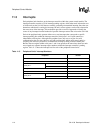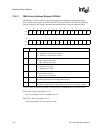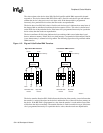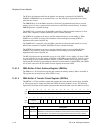
11-6 SA-1100
Developer’s Manual
Peripheral Control Module
11.5 Use of the GPIO Pins for Alternate Functions
Each of the SA-1100’s six peripheral units has a number of dedicated pins that can be used to drive
an LCD display, communicate serially with off-chip devices, or be used as general-purpose digital
input/output pins. Each of the peripherals, except serial port 0 and 2, also has programming options
that allow the unit to take over control of one or more GPIO pins from the system control module
to be used for various special functions. Several control bits must be programmed to enable GPIO
use by peripheral units. First, the user must enable the special function either within the peripheral
unit or within the peripheral pin controller (PPC). Second, the user must enable the GPIO pin to
communicate to the peripheral and select the pin’s direction by programming the GPIO alternate
function register (GAFR) and GPIO pin direction register (GPDR), respectively. See Section 9.1,
“General-Purpose I/O” on page 9-1 for a description of these GPIO registers. Table 11-5 shows the
GPIO pins that can be used for alternate peripheral pin functions.
Table 11-5. Peripheral Unit GPIO Pin Assignment
Peripheral GPIO Pin Function
LCD
Controller
GPIO<2> LDD<8> pin for dual-panel color mode.
GPIO<3> LDD<9> pin for dual-panel color mode.
GPIO<4> LDD<10> pin for dual-panel color mode.
GPIO<5> LDD<11> pin for dual-panel color mode.
GPIO<6> LDD<12> pin for dual-panel color mode.
GPIO<7> LDD<13> pin for dual-panel color mode.
GPIO<8> LDD<14> pin for dual-panel color mode.
GPIO<9> LDD<15> pin for dual-panel color mode.
Serial port 0:
USB
N/A None.
Serial port 1:
SDLC/UART
GPIO<14> Transmit pin for UART when SDLC and UART both needed.
GPIO<15> Receive pin for UART when SDLC and UART both needed.
GPIO<16> Sample clock input/output to SDLC.
GPIO<17> Toggle to drive external tristate for SDLC transmit packets.
GPIO<18> Sample clock input to UART.
Serial port 2:
ICP
N/A None.
Serial port 3:
UART
GPIO<20> Sample clock input to UART.
Serial port 4:
MPC/SSP
GPIO<10> Transmit pin for SSP when MCP and SSP both needed.
GPIO<11> Receive pin for SSP when MCP and SSP both needed.
GPIO<12> SCLK pin for SSP when MCP and SSP both needed.
GPIO<13> SFRM pin for SSP when MCP and SSP both needed.
GPIO<19>
Clock input pin for SSP to drive the frame and sample rates when other than
nonmultiple of 3.6864 MHz needed.
GPIO<21>
Clock input pin for MCP to drive the frame and sample rates when other than
12 Mbps needed.


















